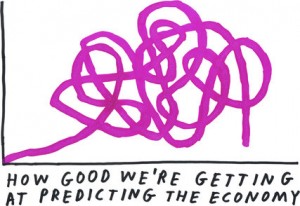Today’s discussion article was a 2011 TREE review paper, ‘Decision making under great uncertainty: environmental management in an era of global change’, by Polasky, Carpenter, et al. (2011). The article provides an introduction to the issue of decision making under ‘deep’ uncertainty – situations where the high uncertainty levels prevent realistic assessments of the probabilities and outcomes that are traditionally used in decision-theory based approaches like maximising expected utility.
The discussion group felt it provided a useful overview of the topic, particularly for those previously unfamiliar with the ideas and tools covered. In this sense the article has been able to serve its purpose as a timely introduction for a conservation/ecology audience. However, we felt that it not quite at the standard of a usual TREE review and that the authors could have aimed for a more in-depth coverage and discussion of some of the issues. There was a tendency to describe the different methods rather than review them more thoroughly and provide a more in depth interrogation of underlying assumptions and implications when in use. It was noted that the fact that this paper arose as the output from a workshop was perhaps then not surprising.
This lack of comparison of strengths and weaknesses between methods was disappointing as we agreed with the authors’ statement that no method for decision making under deep uncertainty (DMUDU) is without its limitations. And it seems likely that understanding these assumptions and their implications is the best way to ensure we don’t misuse them or oversell what these methods can provide. As others have also noted (e.g. Johnson et al (2013), Fischer et al. (2011)), there is a certain amount of rhetoric surrounding the benefits of the approaches recommended by the authors as alternatives to traditional decision theory (scenario planning, resilience thinking, and thresholds approaches), and we felt that this article didn’t really do much to move beyond them and clarify their use. We also thought that the authors’ own backgrounds as proponents of thresholds approaches and resilience thinking methods, for example, did seem to influence their coverage.
We discussed quite a bit the influence that the decision-makers’ values will have in any DMUDU process. With more uncertainty, there is greater scope for values from interested parties, and from scientists ourselves, to influence the decision process and outcomes according to our own beliefs and attitudes. Dealing with values was raised as a key challenge in the article, but again without really providing much guidance beyond broad-brush recommendations[1]. We thought that the coverage and ideas regarding ‘global change’ and ‘global actors’ were also a bit muddled.
Other interesting points that were raised in the discussion included the idea of how we should define impossible versus unpredictable events. This is at least partly an epistemological issue (and thus, I should tread carefully and ask any philosophers to please stop reading now). Because many of these scoping methods still rely to a degree on expert specification of ‘plausible’ scenarios, there is a clear susceptibility to situations where experts rule as ‘impossible’ or ‘implausible’ those events which do actually turn out to occur. The group noted that these perceived possible/impossible scenarios are aligned to our own individual worldviews and perceptions of the way the world works. Particularly when scoping the effectiveness of different policy mitigation actions under different scenarios, it is clear that worldviews might undermine the effectiveness and objectivity of the analysis in practice.
I will be attempting to apply some of these approaches for DMUDU, and when quizzed about their ability to effectively assist with identifying possible ‘unknown unknowns’, I felt I couldn’t say I was confident in their ability to appropriately broaden the scope of the decision process enough to account for all ‘true’ possibilities in practice. In dealing with complex, interconnected socio-economic systems, the unpredictability of actual events, and our ability as humans to overestimate the ability we have to predict into the future is very —indeed, remarkably— consistent (e.g. Shlyakhter and Kammen (1992)).
A take home message for me was the potential benefit for including a stage where we explicitly interrogate ‘impossible’ scenarios as well as part of a comprehensive assessment to avoid some of the problems with too-limited future-scoping. I imagine something like this might be recommended in some of the family of DMUDU protocols that exist, and that’s something I will be looking into. Horizon scanning methods were not touched on in the discussion, but might also have some relevant insights into some of the ideas we were discussing in regards to enhancing rare event predictability. All in all, a great discussion!
References
Fischer, J., Peterson, G. D., Gardner, T. A., Gordon, L. J., Fazey, I., Elmqvist, T., & Dovers, S. (2009). Integrating resilience thinking and optimisation for conservation. Trends in Ecology & Evolution, 24(10), 549-554.
Johnson, F. A., B. K. Williams, & Nichols, J. D. (2013). Resilience thinking and a decision-analytic approach to conservation: strange bedfellows or essential partners? Ecology and Society 18(2), 27. http://dx.doi.org/10.5751/ES-05544-180227
Shlyakhter, A. I., & Kammen, D. M. (1992). Sea-level rise or fall? Nature, 357(6373), 25-25.
Picture Credit: Tucker Nicholas, New York Times
[1] E.g. ‘Guidance to decision-makers should rely on a broad set of models, data and experience to generate insights about the probable desirability of alternative decisions. Analyses should bring to bear what is known as well as what is possible although unknown’.


Pingback: Decision making under deep uncertainty | Skills...